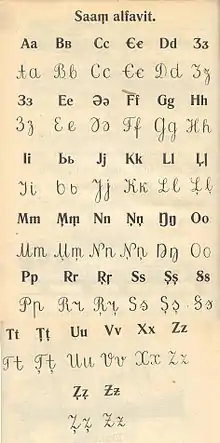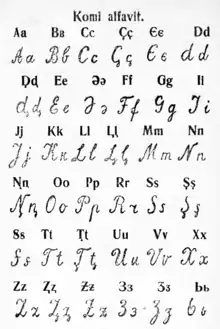I with bowl
![]() ,
, ![]() (I with bowl) is an additional letter of the Latin alphabet. It was introduced in 1928 into the reformed Yañalif, and later into other alphabets for Soviet minority languages. The letter was designed specifically to represent the non-front close vowel sounds IPA: [ɨ] and IPA: [ɯ].[1] Thus, this letter corresponds to the letter ⟨I ı⟩ in modern Turkic alphabets.[2][3][4][5][6][7]
(I with bowl) is an additional letter of the Latin alphabet. It was introduced in 1928 into the reformed Yañalif, and later into other alphabets for Soviet minority languages. The letter was designed specifically to represent the non-front close vowel sounds IPA: [ɨ] and IPA: [ɯ].[1] Thus, this letter corresponds to the letter ⟨I ı⟩ in modern Turkic alphabets.[2][3][4][5][6][7]
| I with bowl | |
|---|---|
| (See below) | |
 | |
| Usage | |
| Writing system | Latin script |
| Type | Alphabetic |
| Language of origin | Yañalif |
| Phonetic usage | [ɯ] [ɤ̆] [ɨ] |
| History | |
| Development |
|
| Variations | (See below) |
| Other | |
Usage
The letter was originally included in the Yañalif, and later also included in the alphabets of the Kurdish, Abazin, Sami, Komi, Tsakhur, Azerbaijani and Bashkir languages, as well as in the draft reform of the Udmurt alphabet. During the project of the Latinization of the Russian language, this letter corresponded to the Cyrillic letter ⟨Ы ы⟩.
In alphabets that used this letter, the lowercase B was replaced by a small capital ⟨ʙ⟩ so that there would be no confusion between ⟨b⟩ and ⟨ь⟩.
 New Turkic alphabet (Yañalif)
New Turkic alphabet (Yañalif) The Latin-based Unified Northern Alphabet
The Latin-based Unified Northern Alphabet.jpg.webp) Kurdish alphabet of 1929
Kurdish alphabet of 1929 Abazin alphabet of the 1930s
Abazin alphabet of the 1930s Sami alphabet of 1933
Sami alphabet of 1933 Komi alphabet of 1934
Komi alphabet of 1934.JPG.webp) Tsakhur alphabet of 1934
Tsakhur alphabet of 1934.jpg.webp) The draft reform of the Udmurt and Komi scripts of 1931
The draft reform of the Udmurt and Komi scripts of 1931
Encoding
The letter I with bowl has not been adopted into Unicode, despite repeated applications. [8][9][10] Instead, computer users can substitute similar letters, either Ь ь (the Cyrillic soft sign) or Ƅ ƅ (Latin Letter Tone Six, the letter that was previously used in the Zhuang alphabet to denote the sixth tone IPA: [˧]).
See also
References
- W. K. Matthews (2013). Languages of the USSR. Cambridge: Cambridge University Press. p. 71. ISBN 978-1-107-62355-2.
- Tatar (tatarça / татарча / تاتارچا)
- Azerbaijani (آذربايجانجا ديلي / Azərbaycan dili / Азәрбајҹан дили)
- Karaim (къарай тили, Karay dili, לשון קדר)
- Khakas (Хакас тілі / Khakas tîlî)
- Kumyk (Къумукъ тил / Qumuq til)
- Tuvan (Тыва дыл / Tyva dyl)
- Karl Pentzlin, Ilya Yevlampiev (2008-11-03). "Proposal to encode four Latin letters for Jaꞑalif" (PDF). Retrieved 2017-10-24.
- Karl Pentzlin, Ilya Yevlampiev (2010-09-24). "Proposal to encode two Latin letters for Jaꞑalif" (PDF). Retrieved 2017-09-28.
- "Proposal to encode Latin letters used in the Former Soviet Union" (PDF). 2011-10-18. Retrieved 2017-09-26.